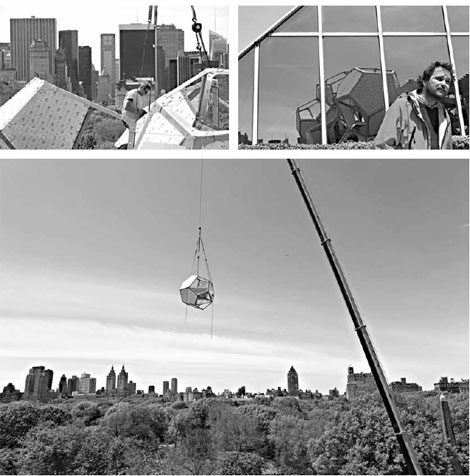Clouds inspire a visionary 'city'
Updated: 2012-05-28 17:16
(The New York Times)
|
|||||||||||
 |
|
The artist Tomas Saraceno says the steel and acrylic modules of his "Cloud City" defy the notions of time and space. Photographs by Richard Perry / The New York Times |
In Tomas Saraceno's imagination his constellation of 16 joined modules on the roof of the Metropolitan Museum of Art in New York will take off in a heavy puff of wind and float over Central Park. "The whole thing will go into orbit," Mr. Saraceno said.
For the past 15 summers the Met's roof garden has been the setting for traditional sculptures by artists like Ellsworth Kelly, Jeff Koons and, last year, Anthony Caro. It has also been a place to walk up a winding bamboo pathway that soared some 15 meters in an untraditional installation that invited visitor participation. But perhaps the most unexpected environment of all is the dizzying multipolygonal habitat of reflective stainless steel and acrylic called "Cloud City."
"Cloud City" is the largest of Mr. Saraceno's 10-year-old series, "Cloud Cities/Air Port City." The Argentine artist described his creation as "an international space station." Mr. Saraceno sneaked a visitor inside and up a twisty staircase about six meters above the roof garden. Some of the floors were transparent, and the walls were mirrored steel, acrylic or open to the air. Suddenly buildings, people and trees were upside down or sideways, sometimes almost spinning around from the perspective inside this giant futuristic construction.
Like many of Mr. Saraceno's installations "Cloud City" is his vision of floating cities that defy conventional notions of space, time and gravity. "You can have a feeling of weightlessness that's a bit disorienting," he admitted.
Anne L. Strauss, associate curator in the Met's modern and contemporary art department, first saw Mr. Saraceno's work at the 2009 Venice Biennale, where molecular webs of black elastic rope enveloped a large white gallery in the main building of the Giardini. The strands themselves were complex crystalline shapes, making the installation as architectural as it was philosophical. The spider's web, whose shapes can be so easily destroyed, were Mr. Saraceno's metaphor for the fragility of the world.
"After I saw that piece, I thought, given his unfettered inventiveness, Tomas would be the ideal artist to create something for this site," Ms. Strauss said, adding that "Cloud City" would be "similar to a telescope looking into the atmosphere."
Mr. Saraceno, 39, is an architect, which is one reason a large part of his practice involves pushing the boundaries of art, architecture and science. He sees this installation as one of his visions for a utopian environment come to life: a creation inspired by both the obvious and the arcane, including, he said, the ideas of Buckminster Fuller; the ephemeral nature of clouds and bubbles, bacteria and foam; and social and neural communication networks.
Mr. Saraceno's experimental installations have been shown extensively throughout Europe and the United States, most recently at the Hamburger Bahnhof in Berlin, where about 20 Saraceno creations were included in a show that closed in February.
When "Cloud City" leaves the Met's roof in November, it will not be seen in public again until the summer of 2013, when it travels to the Green Box Arts Festival in Green Mountain Falls, Colorado, where it will sit in a lush forest.
"I like the idea of malleability, of seeing it surrounded by trees," Mr. Saraceno said. "When it is reassembled in a different place, the sky and the environment will be different; it will change completely."
Related Stories
Folk artists perform for citizens in Taiyuan 2012-05-24 09:56
Minority artists to present arts festival 2012-05-18 13:45
Artist flushes out future wife 2012-05-17 14:55
Artist of the handmade fan 2012-05-15 15:00
Sculpture by Chinese artist unveiled in LA 2012-05-14 16:01
Today's Top News
Rescuers race against time for quake victims
Telecom workers restore links
Coal mine blast kills 18 in Jilin
Intl scholarship puts China on the map
More bird flu patients discharged
Gold loses sheen, but still a safe bet
US 'turns blind eye to human rights'
Telecom workers restore links
Hot Topics
Lunar probe , China growth forecasts, Emission rules get tougher, China seen through 'colored lens', International board,
Editor's Picks

|

|

|

|

|

|





